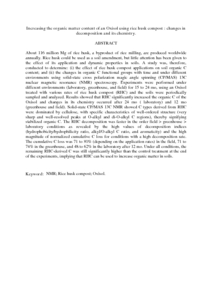Citation
Anda, Markus and Jusop, Shamsuddin and Ishak, Che Fauziah and Syed Rastan, Syed Omar
(2010)
Increasing the organic matter content of an Oxisol using rice husk compost : changes in decomposition and its chemistry.
Soil Science Society of America Journal, 74 (4).
pp. 1167-1180.
ISSN 0361-5995
Abstract
About 116 million Mg of rice husk, a byproduct of rice milling, are produced worldwide annually. Rice husk could be used as a soil amendment, but little attention has been given to the effect of its application and dynamic properties in soils. A study was, therefore, conducted to determine: (i) the effect of rice husk compost applications on soil organic C content; and (ii) the changes in organic C functional groups with time and under different environments using solid-state cross polarization magic angle spinning (CP/MAS) 13C nuclear magnetic resonance (NMR) spectroscopy. Experiments were performed under different environments (laboratory, greenhouse, and field) for 15 to 24 mo, using an Oxisol treated with various rates of rice husk compost (RHC) and the soils were periodically sampled and analyzed. Results showed that RHC significantly increased the organic C of the Oxisol and changes in its chemistry occurred after 24 mo ( laboratory) and 12 mo (greenhouse and field). Solid-state CP/MAS 13C NMR showed C types derived from RHC were dominated by cellulose, with specific characteristics of well-ordered structure (very sharp and well-resolved peaks at O-alkyl and di-O-alkyl C regions), thereby signifying stabilized organic C. The RHC decomposition was faster in the order field > greenhouse > laboratory conditions as revealed by the high values of decomposition indices (hydrophobicity/hydrophilicity ratio, alkyl/O-alkyl C ratio, and aromaticity) and the high magnitude of normalized cumulative C loss for conditions with a high decomposition rate. The cumulative C loss was 71 to 80% (depending on the application rates) in the field, 71 to 74% in the greenhouse, and 48 to 62% in the laboratory after 12 mo. Under all conditions, the remaining RHC-derived C was still significantly higher than the control treatment at the end of the experiments, implying that RHC can be used to increase organic matter in soils.
Download File
![[img]](http://psasir.upm.edu.my/15185/1.hassmallThumbnailVersion/Increasing%20the%20organic%20matter%20content%20of%20an%20Oxisol%20using%20rice%20husk%20compost.pdf)  Preview |
|
PDF (Abstract)
Increasing the organic matter content of an Oxisol using rice husk compost.pdf
Download (86kB)
| Preview
|
|
Additional Metadata
Actions (login required)
 |
View Item |

